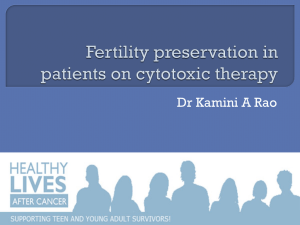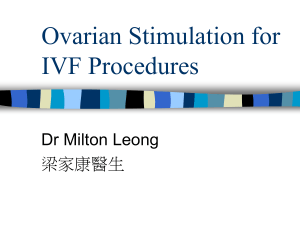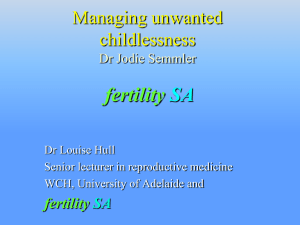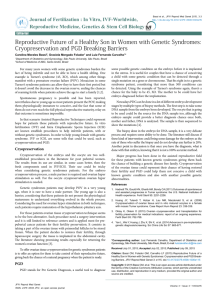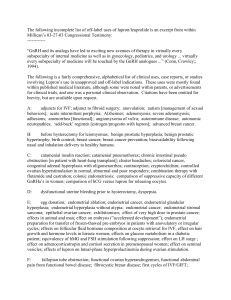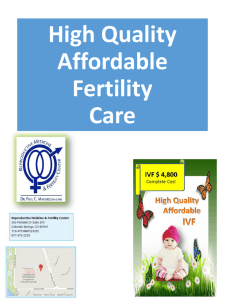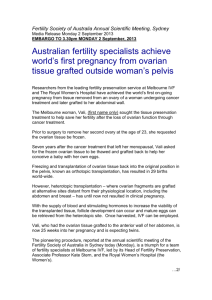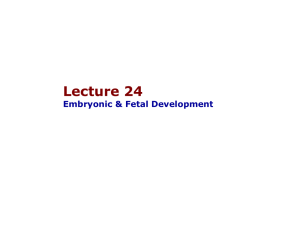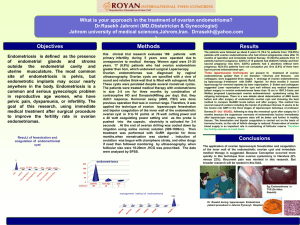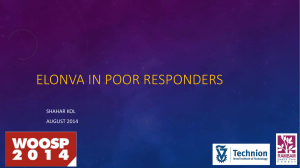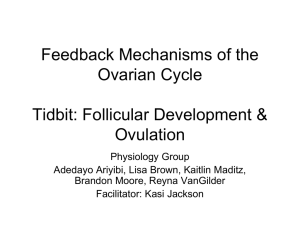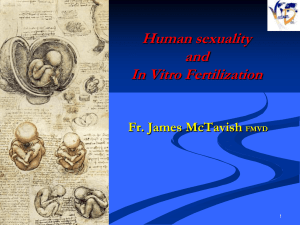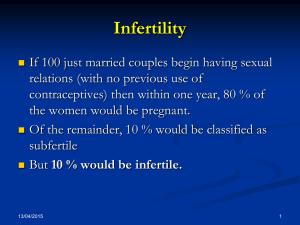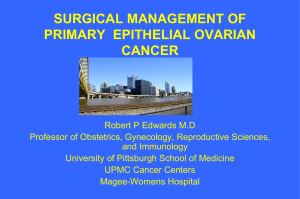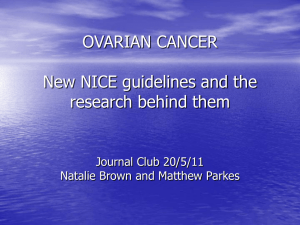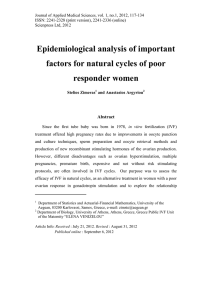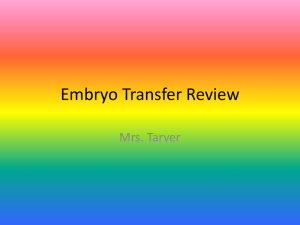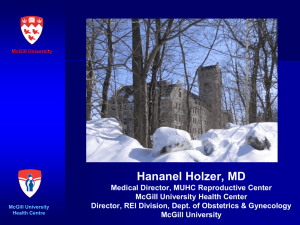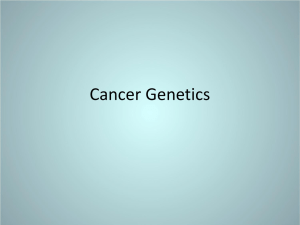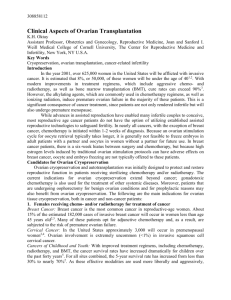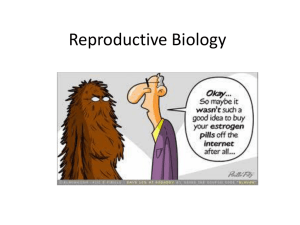Fertility issues for women with malignant disease
advertisement
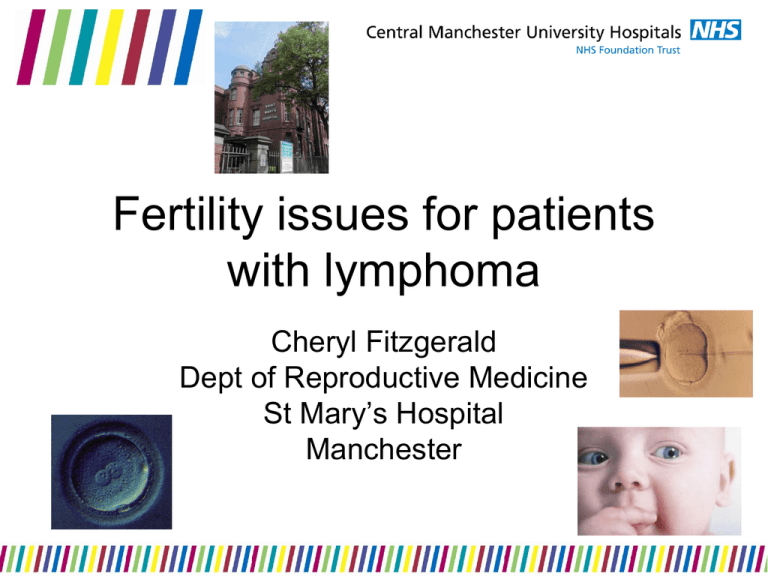
Fertility issues for patients with lymphoma Cheryl Fitzgerald Dept of Reproductive Medicine St Mary’s Hospital Manchester Issues to consider • Two diagnoses – Malignancy and infertility – Counselling • Delay in conception – Marked decline in female fertility 35 onwards • Effect of disease/treatment – Spermatogenesis – Ovary – oocytes – Uterus – radiotherapy induced damage Issues affecting fertility • • • • • • Delay in conception – female Disease Surgery Chemotherapy Radiotherapy Long term prognosis – Welfare of Child • Male • Female • Options - easy • Options complex Men • • • • • • • • Men and postpubertal boys Need to screen for Hep B, Hep C and HIV Urgent direct referral Phone Andrology SMH – 276 6473 Produce single (?more) sample Frozen in several ampoules Stored for up to 55 years Sperm used for insemination or IVF Options for treatment with cryopreserved sperm • Sperm quality good – use for insemination • Sperm quality poor – use for IVF • Treatment within NHS dependent upon NHS assisted conception guidelines • Sperm can be transferred to private sector is not eligible Delay in conception - females Initial treatment Long term therapy (breast) Time until “cure” • • • • Age related decline in female fecundity Age related decline in ovarian reserve Increase in oocyte aneuploidy Marked reduction 35 onwards Effects of chemotherapy • Damage to primordial follicles • Damage to primary follicles • Oogenesis – many months • May be temporary disruption • No benefit from GnRH agonist treatment • No effect on uterus Risk factors for iatrogenic POF • Older women – poor ovarian reserve • Dose, type and duration of chemotherapy • Pelvic radiotherapy / TBI Effects of radiotherapy • Site specific • Pelvic radiotherapy / TBI – profound oocyte damage – profound uterine damage • Oocyte damage – Premature ovarian failure • Uterine damage – Poor implantation rates after XRT – Poor pregnancy outcome after XRT Fertility preservation options – pre-treatment • Cryoprserve ovarian tissue • Cryopreserve oocytes • Cryopreserve embryos • Consider uterine function Ovarian cryopreservation • • • • • • • Laparoscopic oophorectomy Ovarian cortex frozen in strips Later – replace ovarian tissue within pelvis Spontaneous/stimulated ovarian cycle ?? In vitro maturation in the future 10 (+2) babies worldwide No time limit on storage Ovarian storage • Risks • Very low success rates • Risk of laparoscopy • Risk of re-introducing disease • Benefits • No need for hyperstimulation • No raised oestradiol level • No need for partner • Minimal delay in treatment Who is suitable? Lymphoma patients Very young girls ?? Prepubertal No metastatic disease in ovaries Limited time Primordial follicle grafting • Stored ovarian tissue • Primordial follicles grafted into mice • No need to transplant tissue Ref. Brison et al Not published Egg and embryo freezing • Need to retrieve mature eggs from ovaries • No stimulation – single egg – poor success • Need for ovarian hyperstimulation Ovarian hyperstimulation cycle • 10 days of ovarian stimulation – starts with period • NB – delay caused by waiting for menses • Vaginal egg recovery • Ostradiol raised through stimulation Oocyte cryopreservation • • • • problematic chromosomes on spindle aneuploidy after thaw zona pellucida and cortical granule damage affect fertilisation • need for ICSI Oocyte cryopreservation • Freeze all mature eggs recovered • Can be stored for 55 years – HFEA Code of Practice 8 • No reduction in “quality” of eggs with increasing time Oocyte cryopreservation - progress • Improving ++ vitrification • Rapid cooling without crystal formation • Survival • Fertilisation • Pregnancy Vitrification Slow freeze 80% 75% 9% 60% 65% 4% Safety of egg freezing • 936 babies • Birth anomalies – 1.3% • No difference compared to spontaneously conceived children • Noyes et al 2009 Embryo cryopreservation • • • • • • • need a partner “urgent” IVF minimum time 4-6 weeks ovarian hyperstimulation oocyte recovery eggs inseminated embryos created frozen Risks associated with “urgent” IVF for egg or embryo cryopreservation • high circulating oestradiol (20 000 cf 500 pmol/l) – issue with Ca breast • potential seeding of gynae malignancies • delay in cancer treatment Egg and embryo cryopreservation • Risks – High circulating oestradiol – Delay to treatment – Need for partner (embryos) – Risk that partner will “change mind” (embryos) • Benefits – Successful – Proven method – Proven safety Chance of baby – embryo freeze • • • • • • • • HFEA data – livebirth per fresh cycle 2008 <35 years 32.8% 35-37 years 27.3% 38-39 years 19.0% 40-42 years 11.8% 43-44 years 4.8% >44 years 3.8% 30% embryo loss with freezing Embryo freezing • Freeze all embryos created at pronucleate stage • Can be stored for 55 years • No reduction in “quality” of embryos with increased time in storage Practicalities • Urgency – referral early • Fax referral and confirm by phone • Cycle control – COCP – limits delay • Details – Timing of chemo – Need for pelvic radiotherapy – Longterm therapies – Prognosis After treatment • Referred as any infertility patient Egg donation • • • • Donor – IVF stimulation Partner sperm for insemination Embryo(s) replaced in recipient HRT support to 12 weeks of pregnancy • Success rates – 30-50% • Right of child to access donor information Surrogacy • After hysterectomy / pelvic radiotherapy • Problematic +++ • No legal contract • Surrogate – legal mother Eligibility – IVF in NHS • NHS IVF guidelines – Female < 40 years – Stable cohabitation >2 years – One partner childless – Only couples treated – Female BMI< 30 – No previous sterilisation Fertility preservation eligibility NHS • • • • • • Female age ? Cohabitation - ? One partner childless Single women treated BMI ? No previous sterilisation • NB – PCT funding – needs agreement Welfare of the Child • Legal requirement • HFEA Act • Prognosis for patient important • Partner / family support Thank-you
